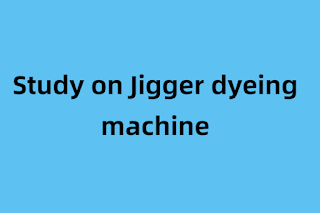Jigger dyeing machine:
Jigg or jigger dyeing machine is one of the oldest dyeing machines used for cloth dyeing operations. Jigger machine is suitable for dyeing of woven fabrics, up to boiling temperature without any creasing. Jigs exert considerable lengthwise tension on the fabric and are more suitable for the dyeing of woven than knitted fabrics. Since the fabric is handled in open-width, a jig is very suitable for fabrics which crease when dyed in rope form.
Jigger dyeing machine is the most commonly used for dyeing all kinds of cotton fabric. There are mainly two types of jigger dyeing machine. One is open jigger dyeing machine and other is closed jigger dyeing machine.
The open jigger dyeing machine is shown in the figure. This machine consists of V shaped stainless steel vessel. Two rollers are fitted above the vessel called as cloth rollers. These rollers are rotated by power. Out of these two rollers one roller is driven by a motor which is called take up roller and the other roller from which the cloth is delivered is called let off roller. When all the cloth is passed from the let off roller to the take up roller, it is called as one end or one turn. The number of ends or turns depends upon the type of the fabric and also the percentage of the shade.
Advantages of Jigger dyeing machine:
Ø The cloth can be dyed in open width form of full width form;
Ø Chemical and heat loses are less when compared to winch dyeing machine;
Ø The material to liquor ratio is 1:3 (or) 1:4 which saves considerable amount of chemical cost and steam cost.
Disadvantages of Jigger Dyeing Machine:
It exerts lot of tension in the warp direction and because of these normally woolen, knitted fabrics, silk etc are not dyed in jigger dyeing machine.
Other problems are:
Ø Temperature control from side-to-side and end-to-end of the roll;
Ø Tension control from end-to-end;
Ø Constant speed control from end-to-end;
Ø Prevention of creases;
Ø Prevention of air.
Limitations of Jigger Dyeing:
Jigs exert considerable lengthwise tension on the fabric and are more suitable for the dyeing of woven than knitted fabrics;
Ø In textile preparation due to the swelling and dissolution of size, which makes the fabric slippery and unstable in roll form;
Ø The low liquor ratio makes washing-off difficult;
Ø There is little mechanical action in a jig machine and it is less suitable where vigorous scouring is required before dying;
Ø Moiré effects or water marks may arise on some acetate and nylon fabrics because of pressure flattening the structure of the rolled fabric.
Related tag:
What is the principle of jigger dyeing machine?
What is jig dyeing machine?
What is the working principle of paddle dyeing machine?
jigger dyeing machine parts
difference between jigger and winch dyeing machine
winch dyeing machine
jigger dyeing recipe
jigger dyeing machine specifications
what is jigger dyeing machine
working of jigger dyeing machine

